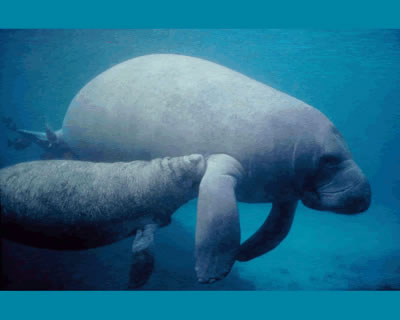|

Description |
| |
| The unmistakable Florida manatee is mostly grayish or brown, often times with algae growing on its thick, wrinkled skin. It is perfectly adapted for life in tropical waters. The body of the Florida Manatee is similar to that of a seal, and its face resembles the face of a walrus without the tusks. Manatees have specialized forelimb flippers that enable them to move through the water with great agility. The manatee's flippers also enable it to grasp food and bring it to the mouth. Manatees have nostrils located at the tops of their heads for easy breathing. Nostrils also have tight-fitting flaps that keep water out when they're underwater. Manatees have incredible lung capacity and can stay under water for as long as 15 minutes. Their presence is often revealed by powerful gusts of air (breaths) at the surface of the water. Their powerful, flat tails help propel their massive bodies through the water. Florida manatees are typically ten feet in length and weigh over 1,000 pounds. |
| |
Diet |
| |
| Manatees are known as "gentle giants" and are purely herbivorous. Manatees eat vast amounts of aquatic plants. Individuals may eat as much as 15 percent of its body weight per day. |
| |
Habitat and Range |
| |
| The Florida manatee is actually a sub-species of the more widespread West Indian Manatee. The Florida manatee summers through much of the east and gulf coasts. Individuals may wander as far north as Virginia and as far west as Louisiana in both fresh and salt water. In winter, Manatees migrate to warm waters off the coasts of Florida and Georgia. Hundreds of Manatees may congregate in winter near large cities such as Tampa and Fort Lauderdale, Florida. Manatees rarely survive in water that dips below 68 degrees F. |
| |
Breeding |
| |
| Manatees are slow moving animals. They are even slower to reproduce. Females become mature after 5 to 9 years and have calves every two to five years. Young Manatees nurse under water and stay with their mothers for about two years. |
| |
Status |
| |
| Manatee populations have have plummeted in America over the last few decades. While natural causes such as disease, red tide, and stress brought on by cold water have certainly had an impact on population, much of the manatee's decline can be attributed to human activity. The destruction of the manatee's wetland habitats for housing developments have been the primary cause of the animal's decline. As humans populated southern Florida at an astonishing rate in the last few decades, they increasingly came into contact with manatees. Collisions with boats, and lacerations inflicted by boat propellers resulted in the deaths of thousands of manatees. Pollution of coastal waters and the careless disposal of fishing lines and other objects into m anatee waters exacerbated the problem. Today, however, strict laws have been implemented making those who interfere with manatees subject to fines and even imprisonment. Many organizations have launched programs aimed at saving Manatees and educating the public. The manatee is the state mammal of Florida, and Sea World has become a driving force in the preservation of "the gentle giant." |
| |
|